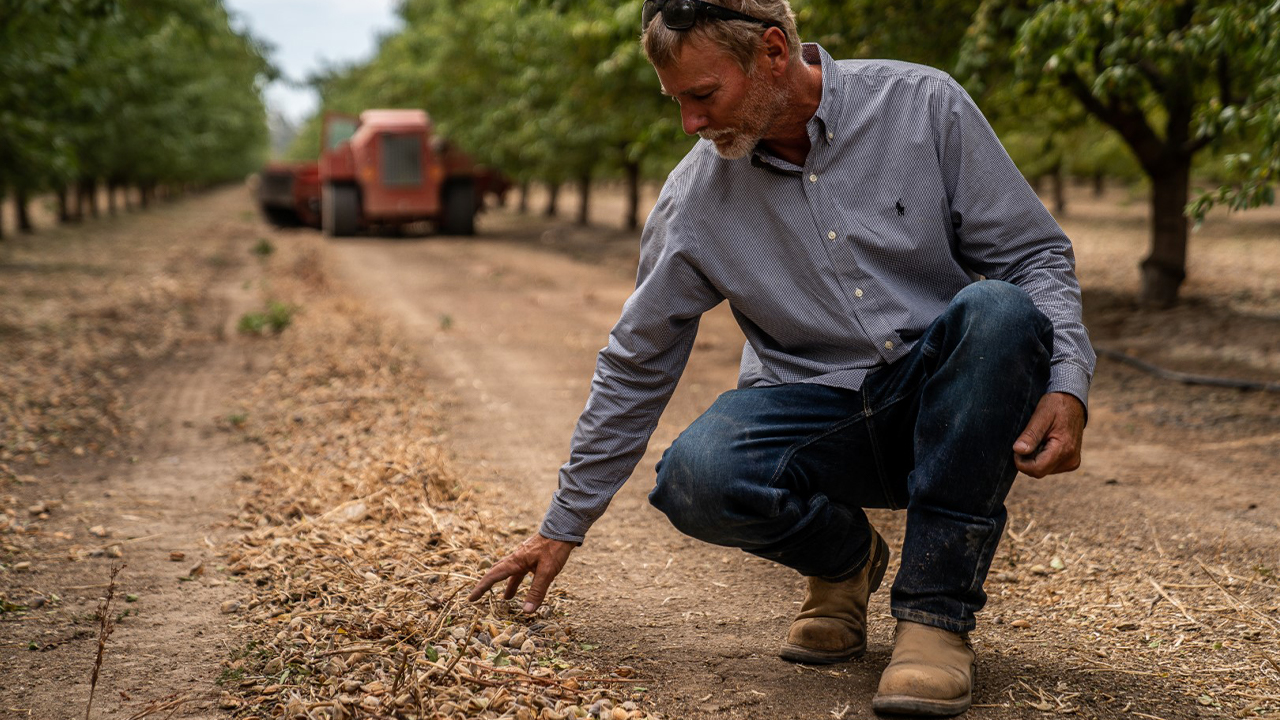As the abnormal almond harvest season comes to a close in mid-October, it's finally time for growers to reflect on their integrated pest management (IPM) program. With input costs at a record high, analyzing what worked and what did not work with your pest control adviser (PCA) and certified crop adviser (CCA) is a good strategy to help maximize your investments for the coming years.

Gerrit Dorrepaal examines almonds in a windrow before the product is processed.
Harvest Sampling/Windrow Sampling
One method for examining your IPM practices is through harvest sampling, also known as windrow sampling.
During a session at the IPM Summit earlier this year, Mateo Marquez, pest control adviser at Integral Ag Inc. said, “The first thing you want to do is establish a protocol. This will vary depending on commodity to commodity or grower to grower, depending on what you’re looking for.”
In most cases, samples will be pulled from the almond orchard right after a shake or from a windrow just before the product is picked up. The sample is then labeled by who it is from, when it was collected, where it was collected, variety, location site, and any other information that may be imperative for data collection.
While some may believe harvest sampling serves the same purpose as grade sheets, there are vast advantages that come from sampling. Grade sheets – the damage report a grower receives from their handler – do not address how certain damages were caused, only that they were present, so sampling compiles a much more thorough report.
Marquez reiterated this when comparing the findings of almond samples from a handler to the findings of Integral Ag Inc. The difference showed what specific pests were present in the kernels and the numbers behind the damage.
When the samples are processed, it’s important that they are cracked immediately or otherwise put in the freezer to avoid mold. Cracking right after collection also helps in detecting larvae and the size of the larvae’s head capsule, which aids in determining the date of infestation, Marquez said.
One of the most valuable benefits to harvest sampling is that the samples collected are as raw as you can get and provide insight to the crop’s “true” total damage.
“When you collect them directly from the field, you get to see a full picture of stuff that maybe got kicked out by the pickup machine or by a color sorter at the processor,” Marquez said. “If you get it from the field, no edits have been made.”
Sampling at the harvest site also eliminates contamination from other orchards, so growers can be confident in the accuracy of the results and make sound financial and management decisions based on those outcomes. If inspected quickly, the grower can troubleshoot issues and adjust harvest timing accordingly.
Though there are some costs associated with harvest samples – approximately $2-3 per acre – it is well worth the investment for the potential IPM cost savings. As sampling becomes a habit, growers can keep records of reoccurring issues, adapt to the needs and characteristics of that orchard, and protect the long-term success of their operation.
Consulting with the Experts
Another key method of ensuring a well-thought-out IPM plan is involving those who know best – your PCA and CCA. Donny Hicks, who works in grower relations at RPAC LLC., joined the session panel to discuss the importance of fostering relationships with PCAs and CCAs.
Not only does Hicks work with growers every day, but he also is a Stanislaus County almond grower himself, so he knows firsthand the importance these individuals serve in ensuring a crop’s success.
“One of the things we do at the end of harvest is he (PCA) gets soil samples, tissue samples, well water samples, and we look at our grades that I get back from the processor,” Hicks said. “We get a game plan together for how we’re going to approach the next season. Without the PCA, it’s difficult for us growers.”
Quality Product to the Handler
Communication doesn’t stop once the product has left the field. In fact, as the product gets closer to market, conversations with grower representatives, hullers and handlers should be constant.
“Anything that you do in the field, I encourage you to talk to your grower reps about,” said Katie Staack, sales manager at Grizzly Nut LLC., and panelist during the session. “Having those conversations, those tough calls right before harvest, is very important to make sure you’re capturing the market.”
Staack explained that handlers strive to make growers successful, but it’s the grower’s job to ensure the product is at top quality until it reaches the handler, which can often be controlled with a proper IPM plan.
“Every packer is different; every grower is different,” she said. “We’re in a unique industry that we’re all in California. Every single packer’s goal is to make you money. So, when you inform us, it makes our job easier to make you money.”
She also encouraged growers to take advantage of funds and programs through the Natural Resources Conservation Service (NRCS) and Farm Service Agency (FSA) to help with on-farm sustainability practices that can support IPM plans and offset costs in low priced years.
All of this is a reminder that successful almond operations start with a solid foundation established at the field level. At the end of each year, it’s a good idea to assess areas of improvement and areas where costs can be decreased.
“Everything you do in the field matters, and it does increase your return on investments,” Staack concluded. “If we don’t have premium products coming from the field, it really impacts us later on in the food chain.”
